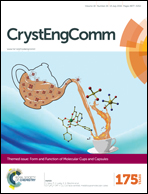Syntheses, structures, luminescence and magnetic properties of three high-nuclearity neodymium compounds based on mixed sulfonylcalix[4]arene-phosphonate ligands†
Abstract
Three attractive high-nuclearity neodymium compounds, namely, [Nd10(BSC4A)4(MePO3)4(Cl)2(OH)4(H2O)2(DMF)8(MeOH)2]·3DMF·7CH3OH (1), [Nd11(BSC4A)3(PhPO3)6(Cl)2(OH)6(DMF)12]Cl·7DMF·2CH3OH (2) and [Nd19(BSC4A)5(PhPO3)5(CO3)6(HCOO)7(OH)8(H2O)7(DMF)12]·11DMF·14CH3OH (3), have been solvothermally prepared based on p-tert-butylsulfonylcalix[4]arene (H4BSC4A) and methylphosphonic acid (MePO3H2)/phenylphosphonic acid (PhPO3H2) ligands. Structural analyses reveal that compound 1 features an oval-shaped Nd10 core, where two neodymium ions are in a large 16-membered wheel with –[Nd–O]– repeating units. Compound 2 displays a novel rugby-like Nd11 nanocage housing two μ4-Cl anions, while compound 3 has a large irregular Nd19 core paneled by unexpected carbonato and formate anions generated in situ and represents the highest-nuclearity lanthanide cluster based on the H4BSC4A ligand to date. In addition, the near-infrared luminescence (NIR) and magnetic behaviors of all the title compounds are also investigated.
![Graphical abstract: Syntheses, structures, luminescence and magnetic properties of three high-nuclearity neodymium compounds based on mixed sulfonylcalix[4]arene-phosphonate ligands](/en/Image/Get?imageInfo.ImageType=GA&imageInfo.ImageIdentifier.ManuscriptID=C6CE00092D&imageInfo.ImageIdentifier.Year=2016)
- This article is part of the themed collection: Form and Function of Molecular Cups and Capsules


 Please wait while we load your content...
Please wait while we load your content...